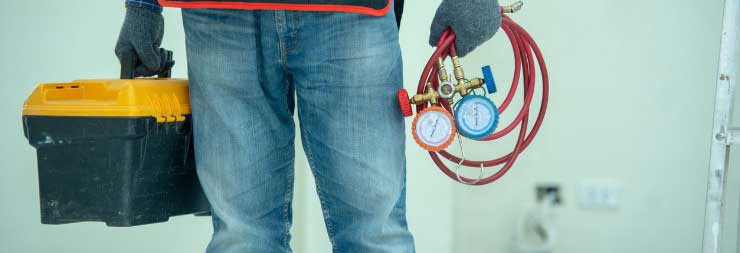Your air conditioner is constantly handling the exchange of hot and cold air. This process naturally creates moisture, which your AC unit is designed to remove through a complex but efficient drainage system. Chief among the parts responsible for effectively removing the buildup of moisture within your AC unit is the drain pipe. This pipe, usually made of PVC or copper, carries excess water from your indoor air handler and disposes of it outside your home. When this small but essential part becomes clogged, however, that water can back up into the system and cause damage not only to your AC unit but also to the surrounding area of your home. But what causes drain lines to become clogged? And does this repair require the assistance of a trained professional, or is it something you can do by yourself?
What causes a clogged AC drain line?
AC drain lines become clogged when buildup occurs within the drainage system. This buildup is usually the result of algae, bacteria, and other microorganisms developing inside the dark, moist environment of the condensate drain line. Other foreign elements like dust and debris can also become lodged in a drain line. While it is the drainage line’s job to remove excess moisture from the AC system, even the best drain can become clogged over time. Neglecting a clogged drain line can lead to extensive damage and costly repairs.
Symptoms of a Clogged AC Drain Line
There are several telltale signs that your AC drain line is clogged.
AC is blowing moldy or smelly air throughout the home.
When algae, fungi, or bacteria build up within your drain pipe, it tends to put off a musty odor. Your air conditioner will then circulate these smelly fumes throughout your home, creating quite an unpleasant experience and putting your indoor air quality at risk.
AC unit won’t turn on or doesn’t function properly.
If the drainage line is not removing moisture from your AC system, water can build up within the unit and cause it to shut down. Excessive moisture in the system can also lead to various malfunctions in your AC unit’s normal operation. Some units — especially newer models — come equipped with an automatic shutoff switch that can detect when water is backing up into the system.
There is standing water in the drain pan of your air handler (indoor unit).
In a normally functioning unit, water drips from the evaporator coils of the indoor unit onto the drain pan, from which it is directed into the drain line and out of your home. If the drain line is clogged, however, this water will continue to back up into the drain pan, which can cause significant damage to your unit if ignored.
There is water damage around the air handler.
Again, if the drain line is not removing excess water properly, the water can back up into the unit or spill out onto the surrounding area, causing damage to the unit itself or to nearby materials.
How to Unclog an AC Drain Line in 5 Steps
While it’s never a bad idea to call a trained AC professional, in many cases you can unclog the drain line yourself. You’ll just need a few household supplies to get started:
Materials Needed
- Wet/Dry vacuum
- Duct tape
- Stiff wire brush
- Rags you don’t mind getting dirty
Step 1. Turn off AC Unit
Before beginning any maintenance or repair to your AC unit, you should always turn off the system. In addition to switching the thermostat off, you should also turn off the switch at your breaker box to ensure a safe work environment for the repair.
Step 2. Check the Drain Pan
If your AC unit’s drip pan has collected water, use your wet/dry vacuum and rags to dry the area out. It’s also a good idea to clean the pan with soap and water in case any mold or bacteria has begun to grow on the surface.
Step 3. Find the AC Drain Line
Your AC drain line runs from the indoor unit to the outside of your home, somewhere near your outdoor unit. Whereas the outdoor opening functions like an open spout that deposits water outside, the opening near the indoor air handler will generally be capped at the end of a T-shaped head. Remove this cap to see into the line and for testing to see if the clog has been fixed.
Step 4. Unclog the Line
If there is a visible clog near either end of the drain pipe, you can use your wire brush to try and dislodge it. Afterwards, simply pour water into the uncapped opening and see if it runs through the line smoothly. If the clog remains, you will need your wet/dry vacuum and duct tape. Outside, attach the wet/dry vacuum to the end of the drain pipe and secure a tight seal with the duct tape. Then, run the vacuum for two to three minutes and assess the clog again by pouring water through the system. If the pipe is still clogged, you can repeat this process. If you are still having trouble unclogging the line, it’s time to call an HVAC professional.
Step 5. Clean the Drain Pipe
After successfully unclogging the drain line, it’s also a good idea to clean it. If the clog was caused by bacterial or fungal growth, cleaning your line can prevent clogs from happening again in the near future. Fortunately, all you need for a thorough cleaning is some distilled vinegar
AC Service in Brevard County
At Colman Air, we understand that sometimes, AC issues happen during the most inconvenient times. This is why we have a 24/7 AC emergency line. Call us if you need assistance ASAP, if you’d like to learn more about faulty capacitors, or to schedule routine HVAC maintenance.
24-HR Emergency Service: (321) 269-4565







Leave a Reply